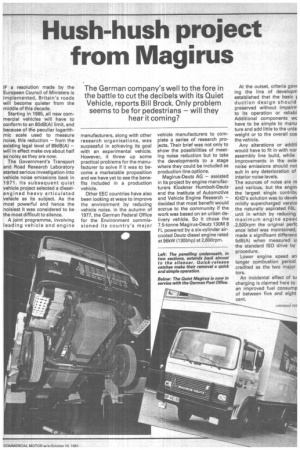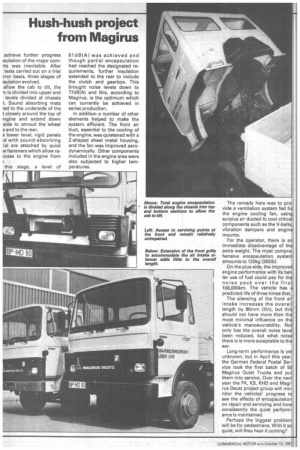Hush-hush project from Magirus
Page 49

Page 50

If you've noticed an error in this article please click here to report it so we can fix it.
The German company's well to the fore in the battle to cut the decibels with its Quiet Vehicle, reports Bill Brock. Only problem seems to be for pedestrians — will they hear it coming?
IF a resolution made by the European Council of Ministers is implemented, Britain's roads will become quieter from the middle of this decade.
Starting in 1985, all new commercial vehicles will have to conform to an 80dB(A) limit, and because of the peculiar logarithmic scale used to measure noise, this reduction — from the existing legal level of 89dB(A) — will in effect make cvs about half as noisy as they are now.
The Government's Transport and Road Research Laboratory started serious investigation into vehicle noise emissions back in 1971. Its subsequent quiet vehicle project selected a dieselengined heavy articulated vehicle as its subject. As the most powerful and hence the noisiest it was considered to be the most difficult to silence.
A joint programme, involving leading vehicle and engine manufacturers, along with other research organisations, was successful in achieving its goal with an experimental vehicle. However, it threw up some practical problems for the manufacturer to solve if it was to become a marketable proposition and we have yet to see the benefits included in a production vehicle.
Other EEC countries have also been looking at ways to improve the environment by reducing vehicle noise. In the autumn of 1977, the German Federal Office for the Environment commissioned its country's major vehicle manufacturers to complete a series of research projects. Their brief was not only to show the possibilities of meeting noise reduction but to take the developments to a stage where they could be included as production line options.
Magirus-Deutz AG — assisted in its project by engine manufacturers Kiockner Humbolt-Deutz and the Institute of Automotive and Vehicle Engine Research — decided that most benefit would accrue to the community if the work was based on an urban delivery vehicle. So it chose the 7.5-tonne Magirus-Deutz 130M 8 FL powered by a six-cylinder aircooled Deutz diesel engine rated at 96kW (130bhp) at 2,800rpm.
At the outset, criteria. gov( ing the line of developm established that the basic r duction design should preserved without impairrr to its operation or reliabi Additional components wc have to be simple to manu ture and add little to the unla, weight or to the overall cos the vehicle.
Any alterations or additi would have to fit in with nor assembly line build, while improvements in the exte, noise emissions should not suit in any deterioration of interior noise levels.
The sources of noise are m and various, but the engin, the largest single contribL KHD's solution was to develc mildly supercharged versior the naturally aspirated F6L unit in which by reducing maximum engine speec 2,500rpm the original perfc ance lebel was maintained, made a significant differenc 5dB(A) when measured LI: the standard ISO drive by procedure.
Lower engine speed an longer combustion period credited as the two major tors.
An incidental effect of tu charging is claimed here to , an improved fuel consump of between five and eight cent. achieve further progress )sulation of the major cornits was inevitable. After tests carried out on a trial Tror basis, three stages of )sulation evolved.
allow the cab to tilt, the is divided into upper and levels divided at chassis t. Sound absorbing mats ied to the underside of the t closely around the top of !ngine and extend down side to shroud the wheel s and to the rear.
a lower level, rigid panels !d with sound-absorbing lal are attached by quick :e fasteners which allow raccess to the engine from r.
this stage, a level of 81dB(A) was achieved and though partial encapsulation had reached the designated requirements, further insulation extended to the rear to include the clutch and gearbox. This brought noise levels down to 77dB(A) and this, according to Magirus, is the optimum which can currently be achieved in series production. • In addition a number of other elements helped to make the system efficient. The front air 'duct, essential to the cooling of the engine, was quietened with a Z-shaped sheet metal housing, and the fan was improved aerodynamically. Other components included in the engine area were also subjected to higher temperatures. The remedy here was to provide a ventilation system fed by the engine cooling fan, using surplus air ducted to cool critical components such as the V-belts, vibration dampers and engine mounts.
For the operator, there is an immediate disadvantage of the extra weight. The most comprehensive encapsulation system amounts to 120kg (2651b).
On the plus side, the improved engine performance with its bet ter use of fuel could pay for the noise pack over the first 100,000km. The vehicle has a predicted life of three times that.
The silencing of the front air intake increases the overall length by 80mm (3in), but this should not have more than the most minimal influence on the vehicle's manoeuvrability. Not only has the overall noise level been reduced, but what noise there is is more acceptable to the ear.
Long-term performance is yet unknown, but in April this year, the German Federal Postal Ser vice took the first batch of 50 Magirus Quiet Trucks and put them into service. Over the next year the FK, KS, KHD and Magirus Deutz project group will mo nitor the vehicles' progress to see the effects of encapsulation on repair and servicing and how consistently the quiet performance is maintained.
Perhaps the biggest problem will be for pedestrians. With it so quiet, will they hear it coming?
























































